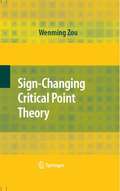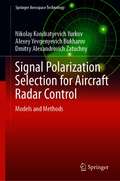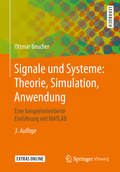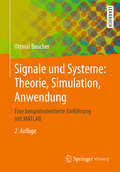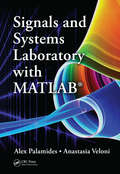- Table View
- List View
Siegel's Modular Forms and Dirichlet Series: Course Given at the University of Maryland, 1969 - 1970 (Lecture Notes in Mathematics #216)
by Hans Maaß<
Sieves in Number Theory (Ergebnisse der Mathematik und ihrer Grenzgebiete. 3. Folge / A Series of Modern Surveys in Mathematics #43)
by George GreavesThis book surveys the current state of the "small" sieve methods developed by Brun, Selberg and later workers. The book is suitable for university graduates making their first acquaintance with the subject, leading them towards the frontiers of modern research and unsolved problems in the subject area.
Sign-Changing Critical Point Theory
by Wenming ZouMany nonlinear problems in physics, engineering, biology and social sciences can be reduced to finding critical points of functionals. While minimax and Morse theories provide answers to many situations and problems on the existence of multiple critical points of a functional, they often cannot provide much-needed additional properties of these critical points. Sign-changing critical point theory has emerged as a new area of rich research on critical points of a differentiable functional with important applications to nonlinear elliptic PDEs. This book is intended for advanced graduate students and researchers involved in sign-changing critical point theory, PDEs, global analysis, and nonlinear functional analysis.
Sign Language Processing: From Gesture to Meaning
by Achraf OthmanIn a world where communication is key to human connection, understanding, and learning from one another, the book investigates the rich and intricate world of sign languages, highlighting the fascinating complexities of visual-spatial languages and their unique role in bridging the gap between hearing and deaf communities through information and communication technology. The book takes a journey through the evolution of sign language processing tools while exploring the cutting-edge techniques used to decipher, analyze, and process them, from the fundamentals of sign language structure and the nuances of non-manual signals to the latest developments in computational linguistics (corpora design, annotation tools, and notation systems), sign language recognition, and machine/deep learning applications. With a mission to reveal the silent language of expression, the author provides a captivating and thought-provoking look into a world often overlooked yet teeming with life and meaning. Offering a comprehensive and engaging overview of the current state of sign language research as well as its prospects, this monograph is an introduction resource for computer scientists, linguistics, educators, academics and sign language interpreters alike. This monograph is an invitation to discover the incredible potential of sign languages to transform human communication, promote inclusivity, and shape the future of technology. The readers will gain a deeper appreciation of the beauty and complexity of sign languages through technology, and they will be inspired to embrace the power of visual communication in our increasingly diverse and interconnected world.
Signal Analysis and Prediction (Applied and Numerical Harmonic Analysis)
by Ales Prochazka N.G. Kingsbury P.J.W. Payner J. UhlirMethods of signal analysis represent a broad research topic with applications in many disciplines, including engineering, technology, biomedicine, seismography, eco nometrics, and many others based upon the processing of observed variables. Even though these applications are widely different, the mathematical background be hind them is similar and includes the use of the discrete Fourier transform and z-transform for signal analysis, and both linear and non-linear methods for signal identification, modelling, prediction, segmentation, and classification. These meth ods are in many cases closely related to optimization problems, statistical methods, and artificial neural networks. This book incorporates a collection of research papers based upon selected contri butions presented at the First European Conference on Signal Analysis and Predic tion (ECSAP-97) in Prague, Czech Republic, held June 24-27, 1997 at the Strahov Monastery. Even though the Conference was intended as a European Conference, at first initiated by the European Association for Signal Processing (EURASIP), it was very gratifying that it also drew significant support from other important scientific societies, including the lEE, Signal Processing Society of IEEE, and the Acoustical Society of America. The organizing committee was pleased that the re sponse from the academic community to participate at this Conference was very large; 128 summaries written by 242 authors from 36 countries were received. In addition, the Conference qualified under the Continuing Professional Development Scheme to provide PD units for participants and contributors.
Signal and Image Representation in Combined Spaces (Wavelet Analysis and Its Applications #Volume 7)
by Yehoshua Zeevi Ronald CoifmanThis volume explains how the recent advances in wavelet analysis provide new means for multiresolution analysis and describes its wide array of powerful tools. The book covers variations of the windowed Fourier transform, constructions of special waveforms suitable for specific tasks, the use of redundant representations in reconstruction and enhancement, applications of efficient numerical compression as a tool for fast numerical analysis, and approximation properties of various waveforms in different contexts.
The Signal and the Noise: The Art and Science of Prediction
by Nate SilverEvery time we choose a route to work, decide whether to go on a second date, or set aside money for a rainy day, we are making a prediction about the future. Yet from the global financial crisis to 9/11 to the Fukushima disaster, we often fail to foresee hugely significant events. In The Signal and the Noise, the New York Times' political forecaster and statistics guru Nate Silver explores the art of prediction, revealing how we can all build a better crystal ball. In his quest to distinguish the true signal from a universe of noisy data, Silver visits hundreds of expert forecasters, in fields ranging from the stock market to the poker table, from earthquakes to terrorism. What lies behind their success? And why do so many predictions still fail? By analysing the rare prescient forecasts, and applying a more quantitative lens to everyday life, Silver distils the essential lessons of prediction. We live in an increasingly data-driven world, but it is harder than ever to detect the true patterns amid the noise of information. In this dazzling insider's tour of the world of forecasting, Silver reveals how we can all develop better foresight in our everyday lives.
Signal Detection for Medical Scientists: Likelihood Ratio Test-based Methodology (Chapman & Hall/CRC Biostatistics Series)
by Ram Tiwari Jyoti Zalkikar Lan HuangSignal Detection for Medical Scientists: Likelihood Ratio Based Test-Based Methodology presents the data mining techniques with focus on likelihood ratio test (LRT) based methods for signal detection. It emphasizes computational aspect of LRT methodology and is pertinent for first-time researchers and graduate students venturing into this interesting field. The book is written as a reference book for professionals in pharmaceutical industry, manufactures of medical devices, and regulatory agencies. The book deals with the signal detection in drug/device evaluation, which is important in the post-market evaluation of medical products, and in the pre-market signal detection during clinical trials for monitoring procedures. It should also appeal to academic researchers, and faculty members in mathematics, statistics, biostatistics, data science, pharmacology, engineering, epidemiology, and public health. Therefore, this book is well suited for both research and teaching. Key Features: Includes a balanced discussion of art of data structure, issues in signal detection, statistical methods and analytics, and implementation of the methods. Provides a comprehensive summary of the LRT methods for signal detection including the basic theory and extensions for varying datasets that may be large post-market data or pre-market clinical trial data. Contains details of scientific background, statistical methods, and associated algorithms that a reader can quickly master the materials and apply methods in the book on one’s own problems
Signal Detection for Medical Scientists: Likelihood Ratio Test-based Methodology (Chapman & Hall/CRC Biostatistics Series)
by Ram Tiwari Jyoti Zalkikar Lan HuangSignal Detection for Medical Scientists: Likelihood Ratio Based Test-Based Methodology presents the data mining techniques with focus on likelihood ratio test (LRT) based methods for signal detection. It emphasizes computational aspect of LRT methodology and is pertinent for first-time researchers and graduate students venturing into this interesting field. The book is written as a reference book for professionals in pharmaceutical industry, manufactures of medical devices, and regulatory agencies. The book deals with the signal detection in drug/device evaluation, which is important in the post-market evaluation of medical products, and in the pre-market signal detection during clinical trials for monitoring procedures. It should also appeal to academic researchers, and faculty members in mathematics, statistics, biostatistics, data science, pharmacology, engineering, epidemiology, and public health. Therefore, this book is well suited for both research and teaching. Key Features: Includes a balanced discussion of art of data structure, issues in signal detection, statistical methods and analytics, and implementation of the methods. Provides a comprehensive summary of the LRT methods for signal detection including the basic theory and extensions for varying datasets that may be large post-market data or pre-market clinical trial data. Contains details of scientific background, statistical methods, and associated algorithms that a reader can quickly master the materials and apply methods in the book on one’s own problems
Signal Extraction: Efficient Estimation, 'Unit Root'-Tests and Early Detection of Turning Points (Lecture Notes in Economics and Mathematical Systems #547)
by Marc WildiThe material contained in this book originated in interrogations about modern practice in time series analysis. • Why do we use models optimized with respect to one-step ahead foreca- ing performances for applications involving multi-step ahead forecasts? • Why do we infer 'long-term' properties (unit-roots) of an unknown process from statistics essentially based on short-term one-step ahead forecasting performances of particular time series models? • Are we able to detect turning-points of trend components earlier than with traditional signal extraction procedures? The link between 'signal extraction' and the first two questions above is not immediate at first sight. Signal extraction problems are often solved by su- ably designed symmetric filters. Towards the boundaries (t = 1 or t = N) of a time series a particular symmetric filter must be approximated by asymm- ric filters. The time series literature proposes an intuitively straightforward solution for solving this problem: • Stretch the observed time series by forecasts generated by a model. • Apply the symmetric filter to the extended time series. This approach is called 'model-based'. Obviously, the forecast-horizon grows with the length of the symmetric filter. Model-identification and estimation of unknown parameters are then related to the above first two questions. One may further ask, if this approximation problem and the way it is solved by model-based approaches are important topics for practical purposes? Consider some 'prominent' estimation problems: • The determination of the seasonally adjusted actual unemployment rate.
Signal Polarization Selection for Aircraft Radar Control: Models and Methods (Springer Aerospace Technology)
by Nikolay Kondratyevich Yurkov Alexey Yevgenyevich Bukharov Dmitry Alexandrovich ZatuchnyThis book highlights the synthesis of polarization selection system in the background of passive noise formed by reflections from space-distributed targets. This synthesis is fulfilled as close as possible to its ideal configuration in terms of maximal signal-to-noise ratio for the matched load of radar station antenna system. It presents a new approach to radar system resolution enhancement based on the development of mathematical model for radiometric receivers with mono-pulse antenna systems, as well as creation of a new algorithm that allows increasing angular resolution during the object’s search and tracking due to special signal processing.
Signal Processing: A Mathematical Approach, Second Edition
by Charles L. ByrneSignal Processing: A Mathematical Approach is designed to show how many of the mathematical tools the reader knows can be used to understand and employ signal processing techniques in an applied environment. Assuming an advanced undergraduate- or graduate-level understanding of mathematics-including familiarity with Fourier series, matrices, probab
Signal Processing and Systems Theory: Selected Topics (Springer Series in Information Sciences #26)
by Charles K. Chui Guanrong Chen"Signal Processing and Systems Theory" is concerned with the study of H-optimization for digital signal processing and discrete-time control systems. The first three chapters present the basic theory and standard methods in digital filtering and systems from the frequency-domain approach, followed by a discussion of the general theory of approximation in Hardy spaces. AAK theory is introduced, first for finite-rank operators and then more generally, before being extended to the multi-input/multi-output setting. This mathematically rigorous book is self-contained and suitable for self-study. The advanced mathematical results derived here are applicable to digital control systems and digital filtering.
Signal Processing, Image Processing and Pattern Recognition,: International Conference, SIP 2009, Held as Part of the Future Generation Information Technology Conference, FGIT 2009, Jeju Island, Korea, December 10-12, 2009. Proceedings (Communications in Computer and Information Science #61)
by Junzhong Gu Hideo Kuroda Tai-Hoon Kim Dominik Slezak Sankar Pal Byeong-Ho KangAs future generation information technology (FGIT) becomes specialized and fr- mented, it is easy to lose sight that many topics in FGIT have common threads and, because of this, advances in one discipline may be transmitted to others. Presentation of recent results obtained in different disciplines encourages this interchange for the advancement of FGIT as a whole. Of particular interest are hybrid solutions that c- bine ideas taken from multiple disciplines in order to achieve something more signi- cant than the sum of the individual parts. Through such hybrid philosophy, a new principle can be discovered, which has the propensity to propagate throughout mul- faceted disciplines. FGIT 2009 was the first mega-conference that attempted to follow the above idea of hybridization in FGIT in a form of multiple events related to particular disciplines of IT, conducted by separate scientific committees, but coordinated in order to expose the most important contributions. It included the following international conferences: Advanced Software Engineering and Its Applications (ASEA), Bio-Science and Bio-Technology (BSBT), Control and Automation (CA), Database Theory and Application (DTA), D- aster Recovery and Business Continuity (DRBC; published independently), Future G- eration Communication and Networking (FGCN) that was combined with Advanced Communication and Networking (ACN), Grid and Distributed Computing (GDC), M- timedia, Computer Graphics and Broadcasting (MulGraB), Security Technology (SecTech), Signal Processing, Image Processing and Pattern Recognition (SIP), and- and e-Service, Science and Technology (UNESST).
A Signal Theoretic Introduction to Random Processes
by Roy M. HowardA fresh introduction to random processes utilizing signal theory By incorporating a signal theory basis, A Signal Theoretic Introduction to Random Processes presents a unique introduction to random processes with an emphasis on the important random phenomena encountered in the electronic and communications engineering field. The strong mathematical and signal theory basis provides clarity and precision in the statement of results. The book also features: A coherent account of the mathematical fundamentals and signal theory that underpin the presented material Unique, in-depth coverage of material not typically found in introductory books Emphasis on modeling and notation that facilitates development of random process theory Coverage of the prototypical random phenomena encountered in electrical engineering Detailed proofs of results A related website with solutions to the problems found at the end of each chapter A Signal Theoretic Introduction to Random Processes is a useful textbook for upper-undergraduate and graduate-level courses in applied mathematics as well as electrical and communications engineering departments. The book is also an excellent reference for research engineers and scientists who need to characterize random phenomena in their research.
A Signal Theoretic Introduction to Random Processes
by Roy M. HowardA fresh introduction to random processes utilizing signal theory By incorporating a signal theory basis, A Signal Theoretic Introduction to Random Processes presents a unique introduction to random processes with an emphasis on the important random phenomena encountered in the electronic and communications engineering field. The strong mathematical and signal theory basis provides clarity and precision in the statement of results. The book also features: A coherent account of the mathematical fundamentals and signal theory that underpin the presented material Unique, in-depth coverage of material not typically found in introductory books Emphasis on modeling and notation that facilitates development of random process theory Coverage of the prototypical random phenomena encountered in electrical engineering Detailed proofs of results A related website with solutions to the problems found at the end of each chapter A Signal Theoretic Introduction to Random Processes is a useful textbook for upper-undergraduate and graduate-level courses in applied mathematics as well as electrical and communications engineering departments. The book is also an excellent reference for research engineers and scientists who need to characterize random phenomena in their research.
Signal Transforms in Dynamic Measurements (Studies in Systems, Decision and Control #16)
by Edward Layer Krzysztof TomczykThis book is devoted to the analysis of measurement signals which requires specific mathematical operations like Convolution, Deconvolution, Laplace, Fourier, Hilbert, Wavelet or Z transform which are all presented in the present book. The different problems refer to the modulation of signals, filtration of disturbance as well as to the orthogonal signals and their use in digital form for the measurement of current, voltage, power and frequency are also widely discussed. All the topics covered in this book are presented in detail and illustrated by means of examples in MathCad and LabVIEW.This book provides a useful source for researchers, scientists and engineers who in their daily work are required to deal with problems of measurement and signal processing and can also be helpful to undergraduate students of electrical engineering.
Signale und Systeme: Eine beispielorientierte Einführung mit MATLAB
by Ottmar BeucherDas Buch behandelt die Theorie der Signale und (linearen) Systeme sowie ihrer Anwendungen. Nach einer Einführung anhand von Beispielen aus den verschiedenen Anwendungsgebieten werden die Grundtechniken zur Beschreibung zeitkontinuierlicher linearer zeitinvarianter Systeme und deren Wirkung auf Signale diskutiert. Der Übergang in die digitale Signalverarbeitung wird durch die Herleitung und Diskussion des Abtasttheorems vorbereitet. Anschließend werden die Methoden der Systemtheorie für die digitale Signalverarbeitung vorgestellt. Ein Schwerpunkt liegt dabei auf der Diskussion der Diskreten Fouriertransformation. Hier stehen insbesondere die Zusammenhänge zwischen DFT/FFT-Spektren und den Spektren der zeitkontinuierlichen Signale im Focus. Die behandelten Methoden werden auf die Verarbeitung stochastischer Signale übertragen und damit für die praktische Anwendung nutzbar gemacht. Der Autor beschreibt zahlreiche reale Beispiele mit echten gemessenen Daten und stellt das Material sowie die zugehörigen MATLAB-Programme online zu Verfügung. Das Buch enthält über 150, in vielen Fällen MATLAB/Simulink-basierte Übungsaufgaben, deren Lösungen in einem eigenen Lösungsband zur Verfügung stehen. Für die 3. Auflage wurden sowohl im Lehrbuch als auch im Lösungsbuch verwendete Bezeichnungen harmonisiert und vereinheitlicht. Alle verwendeten MATLAB-Funktionen und Simulink-Systeme wurden nochmals überarbeitet und an die aktuelle MATLAB-Version angepasst. Sämtliche Grafiken wurden neu überarbeitet. Größen, Schriftart und Schriftgröße wurden vereinheitlicht, um eine bessere Lesbarkeit der Grafiken zu erzielen. Darüber hinaus wurden einige wenige, immer noch vorhandene Fehler aus den Texten eliminiert.Das Buch eignet sich prinzipiell für Studierende aller ingenieurwissenschaftlichen Fachrichtungen und spricht explizit auch die maschinenbaunahen Bereiche an. Aufgrund der ausführlichen Darstellung der Grundlagen ist es jedoch auch für Elektro- und Nachrichtentechniker gewinnbringend nutzbar.
Signale und Systeme: Eine beispielorientierte Einführung mit MATLAB
by Ottmar BeucherDas Buch behandelt die Theorie der Signale und (linearen) Systeme sowie ihrer Anwendungen. Nach einer Einführung anhand von Beispielen aus den verschiedenen Anwendungsgebieten werden die Grundtechniken zur Beschreibung zeitkontinuierlicher linearer zeitinvarianter Systeme und deren Wirkung auf Signale diskutiert. Der Übergang in die digitale Signalverarbeitung wird durch die Herleitung und Diskussion des Abtasttheorems vorbereitet. Anschließend werden die Methoden der Systemtheorie für die digitale Signalverarbeitung vorgestellt. Ein Schwerpunkt liegt dabei auf der Diskussion der Diskreten Fouriertransformation. Hier stehen insbesondere die Zusammenhänge zwischen DFT/FFT-Spektren und den Spektren der zeitkontinuierlichen Signale im Focus. Die behandelten Methoden werden auf die Verarbeitung stochastischer Signale übertragen und damit für die praktische Anwendung nutzbar gemacht. Der Autor beschreibt zahlreiche reale Beispiele mit echten gemessenen Daten und stellt das Material sowie die zugehörigen MATLAB-Programme online zu Verfügung. Das Buch enthält über 150, in vielen Fällen MATLAB/Simulink-basierte Übungsaufgaben, deren Lösungen in einem eigenen Lösungsband zur Verfügung stehen.Für die 2. Auflage wurde das Buch gründlich überarbeitet. Die größten Änderungen betreffen dabei die MATLAB-Beispiele, die sehr oft an die neuesten Versionen der verwendeten Toolboxen angepasst wurden.
Signaling at the Cell Surface in the Circulatory and Ventilatory Systems (Biomathematical and Biomechanical Modeling of the Circulatory and Ventilatory Systems #3)
by Marc ThirietThe volumes in this authoritative series present a multidisciplinary approach to modeling and simulation of flows in the cardiovascular and ventilatory systems, especially multiscale modeling and coupled simulations. The cardiovascular and respiratory systems are tightly coupled, as their primary function is to supply oxygen to and remove carbon dioxide from the body's cells. Because physiological conduits have deformable and reactive walls, macroscopic flow behavior and prediction must be coupled to nano- and microscopic events in a corrector scheme of regulated mechanisms when the vessel lumen caliber varies markedly. Therefore, investigation of flows of blood and air in physiological conduits requires an understanding of the biology, chemistry, and physics of these systems together with the mathematical tools to describe their functioning. Volume 3 is devoted to the set of mediators of the cell surface, especially ion and molecular carriers and catalytic receptors that, once liganded and activated, initiate signal transduction pathways. Intracellular cascades of chemical reactions trigger the release of substances stored in cellular organelles and/or gene transcription and protein synthesis. Primary mediators are included in models of regulated cellular processes, but multiple secondary signaling components are discarded to allow simple, representative modeling and to manage their inverse problems.
Signals and Systems
by S. PalaniThe book is designed to serve as a textbook for courses offered to undergraduate and graduate students enrolled in Electrical Engineering. The first edition of this book was published in 2014. As there is a demand for the next edition, it is quite natural to take note of the several advances that have occurred in the subject over the past five years. This is the prime motivation for bringing out a revised second edition with a thorough revision of all the chapters. The book presents a clear and comprehensive introduction to signals and systems. For easier comprehension, the course contents of all the chapters are in sequential order. Analysis of continuous-time and discrete-time signals and systems are done separately for easy understanding of the subjects. The chapters contain over seven hundred numerical examples to understand various theoretical concepts. This textbook also includes numerical examples that were appeared in recent examinations and presented in a graded manner. The topics such as the representation of signals, convolution, Fourier Series and Fourier Transform, Laplace transform, Z-transform, and state-space analysis are explained with a large number of numerical examples in the book. The detailed coverage and pedagogical tools make this an ideal textbook for students and researchers enrolled in electrical engineering and related courses.
Signals and Systems
by K. Deergha RaoThis textbook covers the fundamental theories of signals and systems analysis, while incorporating recent developments from integrated circuits technology into its examples. Starting with basic definitions in signal theory, the text explains the properties of continuous-time and discrete-time systems and their representation by differential equations and state space. From those tools, explanations for the processes of Fourier analysis, the Laplace transform, and the z-Transform provide new ways of experimenting with different kinds of time systems. The text also covers the separate classes of analog filters and their uses in signal processing applications. Intended for undergraduate electrical engineering students, chapter sections include exercise for review and practice for the systems concepts of each chapter. Along with exercises, the text includes MATLAB-based examples to allow readers to experiment with signals and systems code on their own. An online repository of the MATLAB code from this textbook can be found at github.com/springer-math/signals-and-systems.
Signals and Systems: A Practical Approach
by D. SundararajanThis textbook is designed for an introductory, one-semester course in Signals and Systems for undergraduates. It is written to be concise, clear, and yet comprehensive to make it easier for the students to learn this important subject with high mathematical complexity. The popular MATLAB® software package is used for programming and simulation. Every new concept is explained with figures and examples for a clear understanding. The simple and clear style of presentation, along with comprehensive coverage, enables students to obtain a solid foundation in the subject and for use in practical applications.
Signals and Systems Laboratory with MATLAB
by Alex PalamidesWith its exhaustive coverage of relevant theory, Signals and Systems Laboratory with MATLAB is a powerful resource that provides simple, detailed instructions on how to apply computer methods to signals and systems analysis. Written for laboratory work in a course on signals and systems, this book presents a corresponding MATLAB implementation for



